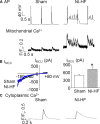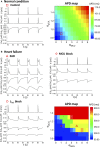Mitochondrial Ca2+ Influx Contributes to Arrhythmic Risk in Nonischemic Cardiomyopathy
- PMID: 29627768
- PMCID: PMC6015427
- DOI: 10.1161/JAHA.117.007805
Mitochondrial Ca2+ Influx Contributes to Arrhythmic Risk in Nonischemic Cardiomyopathy
Abstract
Background: Heart failure (HF) is associated with increased arrhythmia risk and triggered activity. Abnormal Ca2+ handling is thought to underlie triggered activity, and mitochondria participate in Ca2+ homeostasis.
Methods and results: A model of nonischemic HF was induced in C57BL/6 mice by hypertension. Computer simulations were performed using a mouse ventricular myocyte model of HF. Isoproterenol-induced premature ventricular contractions and ventricular fibrillation were more prevalent in nonischemic HF mice than sham controls. Isolated myopathic myocytes showed decreased cytoplasmic Ca2+ transients, increased mitochondrial Ca2+ transients, and increased action potential duration at 90% repolarization. The alteration of action potential duration at 90% repolarization was consistent with in vivo corrected QT prolongation and could be explained by augmented L-type Ca2+ currents, increased Na+-Ca2+ exchange currents, and decreased total K+ currents. Of myopathic ventricular myocytes, 66% showed early afterdepolarizations (EADs) compared with 17% of sham myocytes (P<0.05). Intracellular application of 1 μmol/L Ru360, a mitochondrial Ca2+ uniporter-specific antagonist, could reduce mitochondrial Ca2+ transients, decrease action potential duration at 90% repolarization, and ameliorate EADs. Furthermore, genetic knockdown of mitochondrial Ca2+ uniporters inhibited mitochondrial Ca2+ uptake, reduced Na+-Ca2+ exchange currents, decreased action potential duration at 90% repolarization, suppressed EADs, and reduced ventricular fibrillation in nonischemic HF mice. Computer simulations showed that EADs promoted by HF remodeling could be abolished by blocking either the mitochondrial Ca2+ uniporter or the L-type Ca2+ current, consistent with the experimental observations.
Conclusions: Mitochondrial Ca2+ handling plays an important role in EADs seen with nonischemic cardiomyopathy and may represent a therapeutic target to reduce arrhythmic risk in this condition.
Keywords: arrhythmia; calcium; heart failure; mitochondria.
© 2018 The Authors. Published on behalf of the American Heart Association, Inc., by Wiley.
Figures












Similar articles
-
Enhanced Depolarization Drive in Failing Rabbit Ventricular Myocytes: Calcium-Dependent and β-Adrenergic Effects on Late Sodium, L-Type Calcium, and Sodium-Calcium Exchange Currents.Circ Arrhythm Electrophysiol. 2019 Mar;12(3):e007061. doi: 10.1161/CIRCEP.118.007061. Circ Arrhythm Electrophysiol. 2019. PMID: 30879336 Free PMC article.
-
c-Src Is Responsible for Mitochondria-Mediated Arrhythmic Risk in Ischemic Cardiomyopathy.Circ Arrhythm Electrophysiol. 2024 Oct;17(10):e013054. doi: 10.1161/CIRCEP.124.013054. Epub 2024 Aug 30. Circ Arrhythm Electrophysiol. 2024. PMID: 39212055 Free PMC article.
-
Nonequilibrium reactivation of Na+ current drives early afterdepolarizations in mouse ventricle.Circ Arrhythm Electrophysiol. 2014 Dec;7(6):1205-13. doi: 10.1161/CIRCEP.113.001666. Epub 2014 Sep 18. Circ Arrhythm Electrophysiol. 2014. PMID: 25236710 Free PMC article.
-
Hyperphosphorylation of RyRs underlies triggered activity in transgenic rabbit model of LQT2 syndrome.Circ Res. 2014 Nov 7;115(11):919-28. doi: 10.1161/CIRCRESAHA.115.305146. Epub 2014 Sep 23. Circ Res. 2014. PMID: 25249569 Free PMC article.
-
Late INa Blocker GS967 Supresses Polymorphic Ventricular Tachycardia in a Transgenic Rabbit Model of Long QT Type 2.Circ Arrhythm Electrophysiol. 2020 Aug;13(8):e006875. doi: 10.1161/CIRCEP.118.006875. Epub 2020 Jul 6. Circ Arrhythm Electrophysiol. 2020. PMID: 32628505 Free PMC article.
Cited by
-
Distinct Effects of Mitochondrial Na+/Ca2+ Exchanger Inhibition and Ca2+ Uniporter Activation on Ca2+ Sparks and Arrhythmogenesis in Diabetic Rats.J Am Heart Assoc. 2023 Jul 18;12(14):e029997. doi: 10.1161/JAHA.123.029997. Epub 2023 Jul 8. J Am Heart Assoc. 2023. PMID: 37421267 Free PMC article.
-
A Spatiotemporal Ventricular Myocyte Model Incorporating Mitochondrial Calcium Cycling.Biophys J. 2019 Dec 17;117(12):2349-2360. doi: 10.1016/j.bpj.2019.09.005. Epub 2019 Sep 12. Biophys J. 2019. PMID: 31623883 Free PMC article.
-
MCU overexpression evokes disparate dose-dependent effects on mito-ROS and spontaneous Ca2+ release in hypertrophic rat cardiomyocytes.Am J Physiol Heart Circ Physiol. 2021 Oct 1;321(4):H615-H632. doi: 10.1152/ajpheart.00126.2021. Epub 2021 Aug 20. Am J Physiol Heart Circ Physiol. 2021. PMID: 34415186 Free PMC article.
-
Mitochondrial calcium uniporter complex: An emerging therapeutic target for cardiovascular diseases (Review).Int J Mol Med. 2025 Mar;55(3):40. doi: 10.3892/ijmm.2024.5481. Epub 2025 Jan 3. Int J Mol Med. 2025. PMID: 39749702 Free PMC article. Review.
-
Mitochondrial calcium uniporter channel gatekeeping in cardiovascular disease.Nat Cardiovasc Res. 2024 May;3(5):500-514. doi: 10.1038/s44161-024-00463-7. Epub 2024 May 1. Nat Cardiovasc Res. 2024. PMID: 39185387 Free PMC article. Review.
References
-
- Nuss HB, Kaab S, Kass DA, Tomaselli GF, Marban E. Cellular basis of ventricular arrhythmias and abnormal automaticity in heart failure. Am J Physiol. 1999;277:H80–H91. - PubMed
-
- Ruiz‐Meana M, Fernandez‐Sanz C, Garcia‐Dorado D. The SR‐mitochondria interaction: a new player in cardiac pathophysiology. Cardiovasc Res. 2010;88:30–39. - PubMed
Publication types
MeSH terms
Substances
Grants and funding
LinkOut - more resources
Full Text Sources
Other Literature Sources
Medical
Research Materials
Miscellaneous

